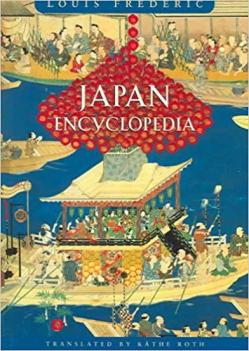Japan Encyclopedia

By Louis Frederic, translated by Kathe Roth
Belknap Press of Harvard University Press (April 30, 2005)
ISBN-13: 978-0674017535
Review by Susan House Wade
The text was originally written as Le Japon: Dictionaire et Civilisation in 1996 by the Paris-based Louis Roth (1923-1996), who also authored a number of other books concerning aspects of Japanese life, as well as on other Asian and South Asian societies and religions.
In his introduction, Frederic states that "knowing Japan and the Japanese better is one of the necessities of modern life." As such, he provides a basic, layman's reference to Japan. Though sometimes incomplete as well as inconsistent, it is difficult to determine whether these discrepancies occurred in the original French version or whether they were created as a result of the translation process, since the French edition was not readily available at the time of this writing. Alphabetisation is also sometimes lacking, although the index could remedy this unfortunate aspect of the encyclopedia.
Wasabi, for example, is defined as a "black radish" under the "sushi" heading, and as a "green radish" under the category "cuisine", which itself tends to ramble and would be well served were varieties of food divided into seasonal categories and/or categories of meal type. Similarly, nori is defined variously as both algae and seaweed.
The author states that the book gives preference to cultural, religious, literary, artistic and historical facts, and to bibliographies, but it also provides some interesting detail on commerce and industry, as well as science, sport and politics. Religions, in Buddhism in particular, receive a great deal of attention, in large part due to the fact that Frederic has previously written on the subject.
From this writer's perspective, the most appealing elements of the Japan Encyclopedia are the clear and informative maps, diagrams and illustrations, which it does successfully present. There is, for example, a chronology detailing 2,000 years of Japanese history. Maps charting the 52 Stations of the Tokaido and of the Prefectures and Major Cities are particularly user friendly. Charts naming "The Thirty-Six Poetic Geniuses" and "The Thirty-Three Temples of the Western Pilgrimage" are also useful.
Japan Encyclopedia would ideally be used in conjunction with other referential sources so as to aid in cross checking the information presented, and this is facilitated by a fairly extensive bibliography, which is included.

